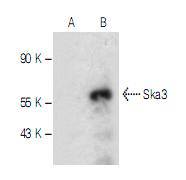Product Detail
Product NameSKA3 Antibody
Clone No.4G1
Host SpeciesMouse
ClonalityMonoclonal
PurificationProA affinity purified
ApplicationsWB, IP, IF
Species ReactivityHu, Ms, Rt
Immunogen DescAmino acids 154-166 within an internal region of Ska3 of human origin
ConjugateUnconjugated
Other NamesC13orf3 antibody RAMA1 antibody SKA3 antibody SKA3_HUMAN antibody Spindle and kinetochore associated complex subunit 3 antibody Spindle and kinetochore-associated protein 3 antibody
Accession NoSwiss-Prot#:Q8IX90
Uniprot
Q8IX90
Gene ID
221150;
Calculated MW46kDa
Formulation1*TBS (pH7.4), 1%BSA, 40%Glycerol. Preservative: 0.05% Sodium Azide.
StorageStore at -20˚C
Application Details
WB: 1:100-1:1,000
IP: 1-2 μg per 100-500 μg of total protein(1 ml of cell lysate)
Western blot analysis of Ska3 expression in non-transfected (A) and human Ska3 transfected (B) 293T whole cell lysates.
Ska3, also designated C13orf3 or RAMA1, is a 412 amino acid protein that belongs to the RAMA1 family of proteins. A component of the SKA1 complex, Ska3 localizes to the outer kinetochore and spindle microtubules during mito- sis. The SKA1 complex is a microtubule-binding subcomplex of the outer kine- tochore and is composed of two Ska1-Ska2 heterodimers, each heterodimer interacting with a Ska3 homodimer . Within the complex, which is important for chromosome segregation and facilitates microsphere movement along microtubules, Ska3 acts as a mediator of microtubule-stimulated oligomeriza- tion. The gene encoding for Ska3 maps to chromosome 13. Comprising nearly 4% of human DNA, chromosome 13 contains around 114 million base pairs and 400 genes. Key tumor suppressor genes on chromosome 13 include the breast cancer susceptibility gene, BRCA2, and the RB1 (retinoblastoma) gene. RB1 encodes a crucial tumor suppressor protein which, when defective, leads to malignant growth in the retina and has been implicated in a variety of other cancers. The gene SLITRK1, which is associated with Tourette syndrome, is on chromosome 13. As with most chromosomes, polysomy of part or all of chro- mosome 13 is deleterious to development and decreases the odds of survival. Trisomy 13, also known as Patau syndrome, is quite deadly and the few who survive past one year suffer from permanent neurologic defects, difficulty eating and vulnerability to serious respiratory infections.
If you have published an article using product 48338, please notify us so that we can cite your literature.



 Yes
Yes



